new posts in all blogs
Viewing: Blog Posts Tagged with: NY11, Most Recent at Top [Help]
Results 1 - 25 of 33
How to use this Page
You are viewing the most recent posts tagged with the words: NY11 in the JacketFlap blog reader. What is a tag? Think of a tag as a keyword or category label. Tags can both help you find posts on JacketFlap.com as well as provide an easy way for you to "remember" and classify posts for later recall. Try adding a tag yourself by clicking "Add a tag" below a post's header. Scroll down through the list of Recent Posts in the left column and click on a post title that sounds interesting. You can view all posts from a specific blog by clicking the Blog name in the right column, or you can click a 'More Posts from this Blog' link in any individual post.
Once again, SCBWI Team Blog had a great time bringing you these highlights of the New York conference!
Being able to meet many of you here at the conference has been wonderful, and we hope we brought a taste of the experience to those of you who weren't able to join us.
We hope to see you at this summer's
40th Annual SCBWI Summer Conference in Los Angeles
August 5th-8th, 2011
It's going to be an incredible event, bursting with inspiration, business, craft and community!
Join us and Mary Pope Osborne, John Green, Jerry Pinkney, Bruce Coville, Laurie Halse Anderson, Norton Juster and many more!
Until then...
Debbie Ohi is a SCBWI Success Story - I saw her earlier in the conference, and we arranged to meet during the autograph party so she could share her experience:
(The SCBWI Illustrator Mentees Blog she mentioned is here.)
Congratulations Debbie - your journey so far is exciting, and we can't wait to hear (and see) the great things you'll be doing!
Namaste,
Lee
Just before the autograph party I had the chance to talk to Lucine Kasbarian about her conference experience:
Congratulations on the publication of "The Greedy Sparrow," Lucine!

Namaste,
Lee
I caught up with Leeza Hernandez after Linda Sue Park's amazing closing keynote, and we talked about the exciting thing that happened to her at this conference:
And here's the artwork she had in the show that won her the grand prize!

Congratulations Leeza!
Namaste,
Lee
One of the most amazing reasons to attend a conference has to be getting to meet someone like Lucy. You can't tell from our blog posts how enthusiastic a presenter is or how good their comic timing is. All I'm saying, guys, is you have to get your butts out here.
Simon & Schuster Art Director Lucy Cummins loves, loves, loves children's books. She's a no-nonsense champion of picture books and their creators. Actually, she's full of nonsense, but you know what I mean. Besides a great session, Lucy provided a six-page handout with fantastic advice and hints. SIX PAGES.
Lucy says she's always looking for new illustrators—her office is a fire hazard from all the postcards and print outs she has out or up on walls.
What's new? What's next?
Lucy provided some insight on what non-trendy trends were trending in picture books these days, a few, but not all of the ones she mentioned are:
SHORT BOOKS, sooo short. Ten words, five words, no words, that kind of short.
THE QUIET BOOK by Deborah Underwood, illustrated by Renata Liwska (are you guys paying attention? Every art director has mentioned this book, though it's not from any of their houses.) AND BOYS, by Jeff Newman, which tells the story in multiple panels of wordless sequences—still elegant without words, says Lucy.
NON-FICTION, picture book biographies are hot, hot, hot.
BARACK OBAMA by Nikki Grimes, illustrated by Bryan Collier. Meghan McCarthy's POP.
Jaime's Favorite Part
Lucy had had her favorite unpublished illustrator's postcard on her wall for four years before she found the perfect first book match for him. That illustrator is Jon Klassen, a personal favorite! And h
Okay, this was brilliant.
Linda Sue is explaining how just like chocolate chip cookies, the way you know you like one or not is because you've eaten a LOT of them. Like 'em crisp, or chewy, or soft, or with nuts? Because you've eaten so many cookies, you have an internal scale against which you can judge any cookie. Even if you've baked them, you know when you eat one if it's something you like, if it's good.
There is only one way to get similar judgement of your own writing: read A LOT.
Build that mental scale.
Read a thousand picture books, like Brenda Bowen suggested. Read 500 novels. But more than that, consider how long it takes to become an expert in other professions - doctors, lawyers, plumbers... all those people need to TRAIN. For years.
Our training is READING!
When Linda Sue writes a mediocre sentence, she knows because she has a vast storehouse of wonderful sentences that she's read in her mind.
We can each build that mental scale for ourselves. And maybe the next book we should all read is Linda Sue Park's latest novel, "A Long Walk To Water."

The humor panel's moderator, Leonard Marcus, you have to sing his name like a song from FUNNY GIRL — "Leonard Marcus! Leonard Marcus! What a beautiful, beautiful, byooooutiful naaaaaaame!"
Lin calls Leonard our residential scholar and a national treasure.

He's the author of among others, DEAR GENIUS, A CALDECOTT CELEBRATION, THE WORD AND THE WAND, and his latest, FUNNY BUSINESS, all about writing humor, which we'll get a taste of in the current panel of Mo Willems, Lenore Look, and Marvin Terban.
Leonard says we have three of the most talented and funniest people in our field on this panel.
Mo Willems, picture book artist and writer. Everyone of his books is an event.
Lenore Look, a very versatile writer with two series of chapter novels and various picture books. She's written about girls and boys, entertaining her audience while introducing them to Chinese culture. Finally, a change at the last minute, sitting in for Douglas Florian is good friend and fine writer,
Marvin Terban. He's known as Mr. English for kids, Scholastic refers to him as "Professor Grammar."
Leonard asks us what makes funny funny? It's well known if you have to explain a joke, that's a problem. He brings up some funny adults writing for adults. Aristotle said we laugh at stories about people not as smart as ourselves. And Will Rogers said everything is funny as long as it's happening to someone else.
Leonard reads an excerpt from a letter Ursula Nordstrom wrote to William Péne du Bois about his illustrations for THE MAGIC FINGER by Roald Dahl "...No place does the author specify the gesture of the finger is done using the middle finger... couldn't you draw the gesture as using the index finger instead?"
Leonard reads another Ursula letter illustrating how to respond to angry letters, this time a letter to Hilary Knight:
Dear Hilary,
I hesitate to worry you, but some enemy of yours is writing me very angry letters and signing your name to them. Have a good week.
Leonard says no one at the conference or on the panel has ever been late with a manuscript or set of illustrations, but imagine receiving this letter from your editor (this went to Edward Gorey):
Dear Edward,
Thanks for your card telling me you are having a nervous breakdown. Welcome to the club. I think you know I have his and hers straitjackets hanging in my closet... If you are stuck or discouraged I might be able to help
Look is laughing! Or certainly keeping kids laughing.
Lenore Look is the author of the Alvin Ho series and the Ruby Lu series. Both are humorous chapter books about surviving the mishaps, misunderstandings and mischief of childhood and feature Asian American narrators.
Lenore never wanted to write humor. She wanted to write grim and dark.
Her first book LOVE AS STRONG AS GINGER was based on her grandmother's life in Seattle working in the crab canneries.
She was asked to do something more uplifting and thought, "Uplifting is good. Okay! I can do uplifting."
Humor is a lot of work. It takes a lot of tweaking and reworking.

When asked to do this panel she was excited, but then concerned because a magician never tells. She ran to the Internet to see what it said about writing humor so she didn't have to give away her secrets.
Humor Secrets (and these are hers):
1. The manner in which you tell. Look tells in a grave manner so that the reader doesn't see the funny coming.
2. Create diversions.
3. Look lets bad, unexpected things to happen to the character and lets things get messy.
4. She gives the character my flaws. Or flaws she's interested in.
5. Preoccupation with self is really good.
6. Spend time with your character and answer all the: who, what, when, and whys.

7. Write to make readers writhe on the floor. Write to make them cry.
Listen to the kids. Kids are funnier than adults. Write down all the funny things you hear.
Look suggests you think about what works for you. What's funny for you?
Here's what works for her:
1. Incongruity
2. Word Play
3. Misheard Words
4. Reversal of Expectations
5. Exaggeration
6. Understatement
7. The Omniscient Reader
8. Embarrassing Moments in Your Life
9. The Shock Value
Sara Zarr delivers the keynote speech to kick off the final day of the 2011 SCBWI Annual Winter Conference.
Sara is the acclaimed author of three novels for young adults: STORY OF A GIRL (National Book Award Finalist), SWEETHEARTS (Cybil Award Finalist), and ONCE WAS LOST (a Kirkus Best Book of 2009). Her fourth book will be out in late 2011. She's also written for IMAGE JOURNAL, Hunger Mountain Online, and RESPONSE MAGAZINE, as well as for several anthologies. (If you need a reading recommendation, ask Sara--she recently read over 200 books as a judge for the National Book Awards.)
Click here to read a pre-conference interview with Sara.
Sara came the the SCBWI conference as an attendee in 2001, at which she had been pursuing writing for five years and becoming frustrated. She came back in 2005 and she was really getting discouraged that things weren't happening in her career.
"They say write the book you want to read. I'm going to give the speech that I need to hear," Sara told us. "I speak to you as a colleague, comrade and friend."
The time between when you're no longer a beginner but have yet to break into the business is probably the hardest in your career, she says. Your greatest creation is your creative life. It's all in your hands. Rejection can't take it away; reviews can't take it away. The life you create for yourself as an artist, may be the only thing that's really yours. Create a life you can center yourself in calmly as you wait for you work to grow.
Here are a few some of the characters tics of a fulfilling creative life that Sara shared with us...
It's sustainable. Celebrate career milestones, but remember that they aren't the point. What's important is the love of the work. "Most creative I know don't have a retirement plan."
It invites company. Most creatives are introverts. Seek mentoring and be a mentor. Other creatives are the only ones who understands the joys and struggles of the creative life. There's never a point where you have nothing else to learn. But at the same time, don't consider hundreds of people on Twitter who you've never meant as your inner circle of friends.
It knows when to send company away. Ultimately this is about you. When it comes to getting your work done, no one can do that but you. There's power and importance to privacy. Think before sharing, name dropping. Know when to turn off Google alerts and GoodReads. "We can't let all of these voices and opinions be present in our creative moment."
It gives back. It give back to you and to others. As you're engaged with you work and your world you'll be a better spouse, friends, sibling. You'll be more self-actualized.
The conference day is almost ready to begin, but there's still time to do what must be done every Sunday morning, read the funny papers. Below are a few of my favorites, but I would love to know what everybody else is reading, too.
Have you all been following SAILOR TWAIN? It's the beautiful online comic written and illustrated by Mark Siegel of First Second (Macmillan.)
 |
| By Mark Siegel |
The lovely Debbie Ohi, are we sure she's not a group of quintuplets she's so prolific? (And remember she won a 2010 SCBWI Summer Conference Portfolio Honor Award and Mentorship Award.) Check out her comics
here.
 |
| By Debbie Ridpath Ohi |
Those of you that attended S&S Art Director Lucy Cummins's sessions might have heard her mention finding illustrator
Chris Eliopoulos from his short comics. He has a few online.
 |
| By Chris Eliopoulos |
Kate Beaton (would be a nice edition to the SCBWI Conference faculty sometime!) has groovy history funnies
here.
 |
| By Kate Beaton |
And if you need just a little bit more Feiffer, a nice
interview with a few extra comics images.
 Lisa Sandell is an executive editor at Scholastic Inc., where she focuses her attention on acquiring and editing middle grade and young adult hardcover novels for Scholastic Press, and she manages the Dear America series.
Lisa Sandell is an executive editor at Scholastic Inc., where she focuses her attention on acquiring and editing middle grade and young adult hardcover novels for Scholastic Press, and she manages the Dear America series.
With so much negative currently being said about the industry, Sandell sees a lot pointing to the light ahead.
*eReaders
*Accessibility is revolutionary. When someone mentions a book, instead of finding a scrap of paper and jotting it down (to be lost in the bottom of your purse), a person can pull out an electronic device (like the ipad) and instantly own the book.
*New concepts in publishing, like the 39 CLUES series.
*Readers can now connect with authors easily.
No new technology has every obliterated the need for storytelling. Quite the opposite.
1 Comments on Lisa Sandell: What Makes Your Work Publishable, last added: 1/29/2011
 Ginger Clark
Ginger Clark has been a literary agent with
Curtis Brown since the fall of 2005. [Curtis Brown has been around since 1914, and has three agents that focus on children's books. Curtis Brown was founded by the legendary Marilyn Marlow.]
She has more than 30 clients. She's currently looking for MG sci-fi, fantasy and mystery, urban fantasy (no vampires), YA sci-fi, dystopia, space opera, YA cyperpunk and steampunk, YA contemporary and literary. She's taking on new clients and prefers email queries [address: gc(at)cbltd.com].
Publishers are finding MG tough right now, she says, because they haven't found a Facebook for MG readers. MG one of the areas of BFYR where you can have successful stand-alone books. You can continue to do that as an MG writer more so than in YA, she says.
Children's books are strong and aren't moving to e-books like the adult segment of publishing, and writers don't make as much off of e-books. Kids pass books around, treasure them as possessions. Teen are experiencing digital fatigue, and need books to decompress from technology.
YA in a nutshell over the past few years according to Ginger: Vampires led to faeries which led to werewolves which led to angels which led to dystopia. She predicts historical is next in line (the Tudors for teens).
Things that came up during Ginger's Q&A:
- She doesn't send a book out these days unless it's had at least one revision.
- Step one, right a
Patricia Lee Gauch is
one amazing woman. Patti is not only a published author herself (Christina Katerina and the Box, Thunder at Gettysburg, andThe Knitting of Elizabeth Amelia), she has edited some of the finest writers in the business: Brian Jacques, T.A. Barron, Andrew Clements, Jane Yolen, Janet Lisle, Katherine Erkskine, and Barbara Joosse.
Conference goers were told that panelist David Small could not be here this morning due to a death in the family. Our condolences to David and his family.
 Mark Teague is here in David's stead. You may know him from his great picture books like DEAR MRS. LARUE, and the HOW DO DINOSAURS series (written by a little-known author named Joan Yelon.)
Mark Teague is here in David's stead. You may know him from his great picture books like DEAR MRS. LARUE, and the HOW DO DINOSAURS series (written by a little-known author named Joan Yelon.)
Mark spoke after Jane. He agreed that her advice applies to illustrators, too, illustrators are in service to the same thing, it's just a different means of telling stories.
Mark says the first task of an illustrator: Be a good reader.
You want to get the story viscerally, understand the mood and rhythm and put that in your art.
Mark's technical advice to illustrators:
Learn by trial and error, that's how you find your voice.
It may be a worthy project to study or even imitate other artists, to learn the craft that way, but eventually you need to find your own voice. You find your own voice through just doing the work.
There are no rules for illustrators, but one, says Mark:
Whatever you do as an illustrator, you are always in service to the story.
Will something that looks great in your studio look great in the story? Will it serve the child reader? It's not a podium for your art, it's a book for a kid.
More importantly than learning to read from picture books is learning
why it is important to read. That's all happening in picture books and affects the rest of a person's life, not to put any pressure on you authors and illustrators out there!
Mark's final comment:You are involved in something important and need to bring your best work.
Books for autographing!
SCBWI swag!
No sales tax!
Open all weekend!
Stop in for some conference-y shopping!
 |
| Convenient hours! |
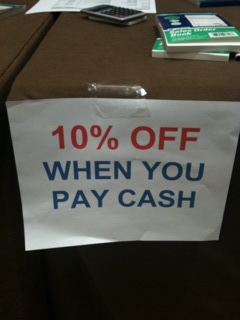 |
| Savings! |
 |
| More savings! |
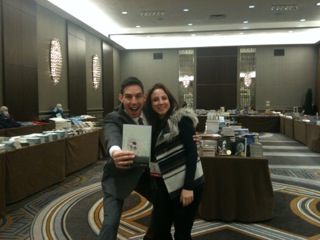 |
| Enthusiastic and friendly staff like Aaron and Liz! |
 |
| SCBWI merch! |
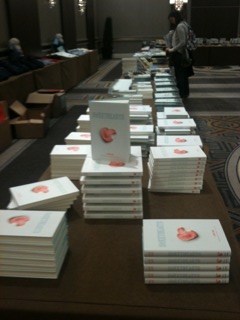 |
0 Comments on Visit the SCBWI Conference Bookstore! as of 1/1/1900
 Only a handful of the attending illustrators have had their artwork licensed, but 99% would like to know how to make that happen. You might remember Suzanne Cruise from when she spoke on licensing a few years ago. But Penny Sikalis is a new-to-SCBWI presenter from Surtex with a really fabulous offer for all the illustrators at today's panel. FREE BADGE to the Gift Fair happening this weekend at Javits Center,—thanks, Penny! Only a handful of the attending illustrators have had their artwork licensed, but 99% would like to know how to make that happen. You might remember Suzanne Cruise from when she spoke on licensing a few years ago. But Penny Sikalis is a new-to-SCBWI presenter from Surtex with a really fabulous offer for all the illustrators at today's panel. FREE BADGE to the Gift Fair happening this weekend at Javits Center,—thanks, Penny!
First, Penny went over the absolute basics of art licensing:
- Art Licensing = Legal permission given to a manufacturer to produce and sell products using your art for a fee
- Artist = Licensor
- Manufacturer = Licensee
Initial steps to get into licensing? Research, research, research! - Take classes
- Visit trade shows
- Look at types of products and companies that sell these products and start a list
 | | from http://cococakecupcakes.blogspot.com/2009/03/hungry-caterpillar-cupcake-party-train.html |
Usually the best style/type of art for licensing is flat, in color, in collections (A collection is approximately six or more images of the same central character (like a snowman) with coordinating patterns, spot art, color schemes, secondary characters, and with multiple sketches of the central character), and mainstream. If you can draw a character, you can license your art. Major Categories of products that need art (subcategories not listed) apparel, craft/hobby, bedding, gift, home decor, publishing, stationery, tabletop (dishes, etc.), textiles, bath. Your goal as an artist is to license the same piece of art to different manufacturers of different types of products so that you can get paid multiple times for that one piece. Something you can't do with one piece of bubble gum, one kitten*, or one copy of nuclear weapons blueprints. Seventy-five percent of the Surtex show (SURface Trade EXpo) is devoted to art licensing. Links: http://www.artlicensinginfo.com, LinkedIn art licensing group, and surtex.com's monthly e-newsletter called On the Surface for more tips on getting started in art licensing. *You might be able to license a kitten, I really don't know.
 | | l to r: Aaron Hartler, Nancy Conescu, Rachel Griffiths, Michelle Poploff |
SCBWI's own Aaron Hartzler moderates a panel of editors offering post-critiqe advice. Here are some highlights. Nancy Consescu (Dial): Revision is a process. Post critique, you have to consider the various comments, decide how to address things, and try different things until you get to what works. She asks her authors to start with making big changes that will resonate through the manuscript. She suggests really looking at your chapter endings and be sure you're giving readers a reason to turn the page. Also really look at the dialogue specific to each character to be sure what they say rings true to each character. She stresses, as you work with an editor, that there's a period of digesting the suggestion that must take place. Rachel Griffiths (Scholastic): She hopes that a manuscript has been revised maybe ten times by the time it gets to her. She suggest that writers pay attention to what you're feeling as you read it--does your mind wander, is something is confusing? If you're ever stuck on a revision, you just work on it, go over things over and over again, and it eventually it can turn into something magical. She reads through and looks for one flash of greatness in a mediocre manuscript, and suggests her authors revise the rest of the pages to get to that level. She hopes that's authors take about 50% of her revision suggestions and that they don't work with the suggestions that don't feel true to them. She stresses the importance of working on your craft because that's what makes you get better and better and grow as a writer. Michelle Poploff (Delacorte): (Note: She was the editor for this year's Newbery winner MOON OVER MANIFEST by Clare Vanderpool, the first debut author to win the award in 30 years. Also note: She's found four authors at SCBWI conference over the past few years.) The revision process between writer and editor varies depending on authors preferences and working style. She always tells authors to read out loud and she's a big fan of writers groups, saying that if you belong to a writing group, they can be very helpful advocates. She also suggests writers let things percoloate for a while as you revise. Revision is like redecorating, and sometimes you rearrange all the furniture in the room, and still there's still a lamp that's in the wrong place. She wants authors she works with to take their time to do the very very best they can on revising.
A note to all those not attending this year's conference: I am sorry, we wish you were here.
Maybe you would like some sensory details of this morning's intensives?
SEE: It might be hard to tell from the photo, but the ballrooms are decorated in Shabby Chic Bug Cocoon. Or like we are in a really fashionable beehive. Or nostril. I think we made all these jokes last year.
HEAR: Another conference going on here concurrently that does a lot of applauding and singing of the national anthem. TOUCH: SCREEN! Lots of App talk for the Illustrators Intensive. SMELL: This morning there was delicious free coffee, fresh bagels and loads of shmears. But then there was also this plate of onions. TASTE: Unless you ate the onions and can only taste old onion, most everyone else is tasting POSSIBILITY! Which tastes like a cross between cotton candy and Four Loko. No, really, feedback on your manuscripts in the Writers Intensive and groovy insights into app-making, licensing and beyond the book topics for illustrators is making for a truly invigorating Friday that we wish you were here for, too.
We're glad you're reading the Winter Conference blog!
You can also following the action on Twitter:
As the Writers Intensive attendees returned back refreshed from lunch, I grabbed a few to see how their morning session went. Here's what they had to say:
"Nancy Conescu was absolutely fabulous and really inspired everyone at our table." -Alison Formento
"I learned so much from listening to everybody's manuscript and hearing what Rachel Griffiths had to say about every manuscript. Well worth it."-a shy attendee
"I really enjoyed hearing the different genres, styles, and age ranges." -Sean Walsh
"Bonnie Bader shared a great suggestion that instead of using exposition use dialogue organically to show who the character is. That applied to everyone at the table." -Suzannah Gilman
"There wasn't a wasted second. Everyone at the table gave sharp, smart criticism." -Lauren Monahan
We all love Dan Yaccarino's work. His books, his cartoons, his puzzles, his pajamas, his new line of hams available at Costco. Dan shares examples of how he's taken his book art beyond books and gives hints on how illustrators can make that happen in their own careers. For most things—plush toys, games, stationery—those beyond-the-book items are really only an option after a book has come out, sold well, and art licenses are picked up by different manufacturers or the publisher. Dan says consider making your own promotional items, like at cafe press, to get the ball rolling. We know Dan has awesome cartoons, but how do you get started in that? You attend the animation equivalent of an SCBWI conference, KidScreen Summit.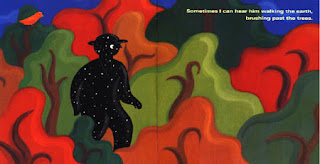 | | from Good Night, Mr. Night |
Dan talked briefly about good self-promotion for illustrators, he thinks post cards are still a great way to get your art in front of the people that matter, cards often having a longer shelf life than an image in an email. A website and/or blog that conveys your personality is also key for illustrators. For those with books out, he recommended making your own book trailers using iMovie and royalty free assets. Simple is always best, though, let the work shine through.  | | from Every Friday |
His number one piece of promotion advice: PROMOTE THE WORK YOU WANT TO GET.  | | from the forthcoming All the Way to America |
What's Dan working on now? He's got a chapter book in the works, one that he's both written and illustrated. And in addition to new picture books and new TV show ideas he's got a great a new line of Yaccari
Our morning started off with a welcome from Cecilia Yung, SCBWI Board Member and AD and VP at Penguin. This year's intensive is a different format and focus from previous years. BEYOND BOOKS: Picture Books and the New Media. There are no hands-on art workshops or art director round tables today, but lots of exciting discussions concerning art licensing and apps with plenty of time for questions from the audience.
 | | One of Cecilia's books for Putnam, written and illustrated by SCBWI member Jesse Joshua Watson |
Cecilia prepped us for the tone of the day: Viable ideas with always thrive, survive and multiply in different forms and formats. We are not here to argue digital vs. print, we are here to talk about picture books and the visual opportunities presented by all these forms. She urged us to imagine completely new concepts, completely new artwork that will take advantage of all the new formats available today.
The SCBWI Writers Intensive is underway and the room is now halfway through the morning session.
Over 200 writers and 26 agents and editors fill the ballroom with the intense excitement only the this event can bring about.
Let the reading and critiquing begin.
Welcome to SCBWI TEAM BLOG coverage of the 2011 Annual Winter Conference. Check in often throughout the weekends as we offer live coverage of the conference as it happens.
Today offers a Writers' Intensive and an Illustrators' Intensive.
Before the Writers' Intensive critiquing kicks off, an agent and two editors are offering advice about handling a critique situation.
Edward Necarsulmer (McIntosh and Otis): Do your best to listen, but also understand that I'm just one guy. There are plenty of books out there that I've passed on that have become bestsellers. (He's found 3-5 novels through SCBWI events.) He gets that the idea of criticism in general can be hard to hear, but it's about turning off the defensiveness, and understand the critique for what it's worth.
Julie Strauss-Gabel (Dutton Children’s Books): The thing that surprises her most is when she asks, "What is this about." She find writers often don't really know what they're writing about--her assessment is very out of line with what the writer thinks she's putting on the page. Critiques are about being open--it's part of your professional process. There's nothing personal about it. At least stop to think about why you are hearing a particular critique or why certain questions were asked. If you're in a ccritique group, remember that they only work if they include honest discussion.
Liz Szabla (Feiwel and Friends): I find gold here. (She's currently working with two writers who she discovered at the SCBWI Winter Conference.) Remember that editors are thinking about your work in terms of the market. Go into a bookstore and really look at what the market is right now. She finds that a lot of writers are really surprised when she talks about market--but market is important. Critiquing with editors and agents, is a way to get another sort of compass as to where you are with your writing.
 Ten days until conference time! The latest SCBWI TEAM BLOG interview with Annual Winter Conference faculty was posted today by Lee Wind on his blog I'm Here. I'm Queer. What the Hell Do I Read? Ten days until conference time! The latest SCBWI TEAM BLOG interview with Annual Winter Conference faculty was posted today by Lee Wind on his blog I'm Here. I'm Queer. What the Hell Do I Read? Lee interviewed Putnam Publisher Jennifer Besser. Jennifer will offer breakout sessions on "What Makes Your Work Publishable: Today's Market in Children's Books" concurrent with a number of other editors, agents and art directors.
Below is a bit from Lee's interview. Click here to read the full post. Jennifer Besser is the Publisher of G.P. Putnam’s Sons, an imprint of the Penguin Young Readers Group. Prior to joining Putnam in April 2010, Jennifer was an Executive Editor at Disney Hyperion, and before that, she got her start in publishing at Miramax Books. And her very first job was at age 11, selling popsicles on Venice Beach. She much prefers her current gig. Jennifer manages a stellar team of editors and also edits children’s books for all ages, from picture books to young adult fiction. She is the editor of Rick Riordan’s #1 New York Times best-selling Percy Jackson and the Olympians series, as well as the Red Pyramid.
You can still register for the event--it starts January 28th--and get a chance to see Jennifer Besser and a host of other publishing professionals in person.
View Next 7 Posts
|








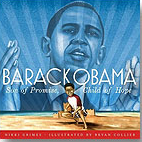

















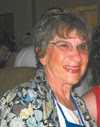




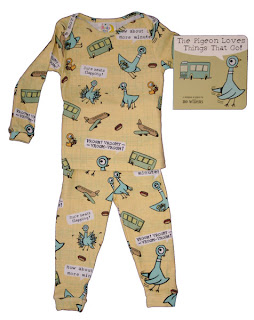









I had a Great Time! Thank You
Thanks for a great conference. Here is a link to my ramblings about the weekend. http://sarahdoyle13.blogspot.com/2011/01/inspirational-weekend.html
It was m,y first time at a national conference. A little overwhelming for a first timer, but everyone I met was sooooo nice and inviting. And there was such a real sense of community amongst the throngs. Thank you for all of your posts. Don't know if I'll be in LA yet, but I'll try.
~Cheers